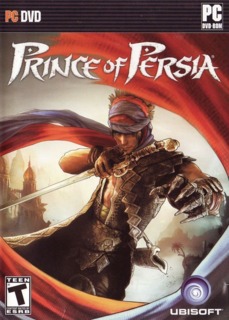Easy controls and gamer-friendly design make Prince of Persia the most "playable" platformer on the market.
As you begin the game, the main character, Prince, is wandering a desert looking for his lost donkey. A few seconds later, he's chasing after a beautiful princess who is a bit irritated with her father for having released a dark god of doom and destruction upon the world. This instant jump into the action is what a player can expect from the game: a narrative that does not take a break for a second.
To start, the artwork in this game is simply incredible. Yeah, fancy graphics have become old news in the game industry, especially in this latest console generation. But there is something about Prince of Persia's art style that truly captivates. I have never been a gamer who stops to gaze out over a video game's pixilated horizon; but in Prince of Persia, you really can't help yourself. Some of the more expansive views look straight out of 1001 Arabian Nights.
Yet while graphics can "wow" me, as a gamer, it all comes down to the gameplay, and Prince of Persia is one of the most "playable" platformers on the market. Most of your jumps, grabs, and gravity-defying ceiling crawls are executed by one push of a button. In most cases, your movement joystick is only needed to point the Prince in the right direction for the first jump, and then the rest of the platforming sequence is just a timed sequence of button presses. Incredibly simplistic: yes. But the Prince looks so awesome doing it, I didn't much care it was so easy to do such awesome looking stuff: wall running across a thousand foot chasm, navigating a broken bridge across a mountainous abyss, it all looks great, feels great; but it can't really be called challenging.
Should you ever find yourself plummeting helplessly into some crevice, and you will, you'll find the game's "death" system refreshingly forgiving. Your partner throughout the game, the Princess Elika, will use her teleportation magic to grab your hand and plop you back on the platform you just left. As a gamer, you know you just "died", but the game doesn't punish you by forcing you to a loading screen, nor does it give you a limited number of lives to work with. Elika never gets tired of saving you, and I appreciated how this system kept the game flowing smoothly. You won't be kicked out of the story to a loud "Prince? Prince! PRIIINCE!", followed by an agonizingly long load screen that gives you time to strew in your own failure.
The combat is almost as simplistic as the jumping around. The only addition is the Prince's ability to block and riposte attacks. Fights are always a one-on-one duel, and players can effortlessly chain together some visually stunning combos. Like in the platforming sections, being defeated simply means Elika will use her magic to save you, and you are punished slightly by the enemy regaining a portion of its health, but the battle continues regardless. This portion of the game can be frustrating, especially as the enemies increase in difficulty near the end of the story. You'll find that the enemies don't have to follow the same rules you do. If they riposte one of your attacks, you better start blocking because that counterattack is going to be faster than your next attack could ever be. However, if you riposte one of your enemy's attacks and try to counterattack, more often than not you'll be on the ground, bleeding, wondering what happened. Combat momentum NEVER works in the player's favor, and this can make for player frustration. Yet as combat is really a small portion of the game, this issue can not ruin, nor even really mar, a great gaming experience.
As a cherry-on-top, the dialogue between the Prince and Princess is actually quite good, even laugh-out-loud worthy at some points. The development between the two characters adds a sense of life to the otherwise dull, evil-god-is-escaping-his-prison plot line. In the end, Prince of Persia is a game that gamers should treat themselves to playing. Is the story long enough to validate a $60 price tag? No, I would say not. But in the case of a rental or a $20 used game, you really won't find more bang for your buck anywhere in the game industry.

